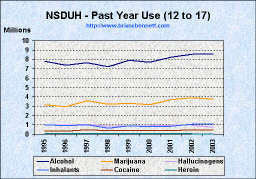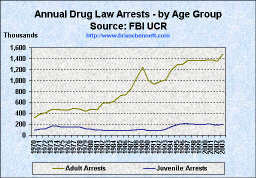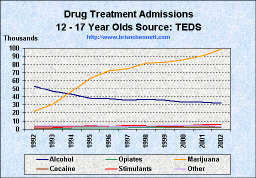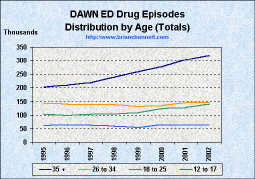|
"Random student drug testing allows us to use the knowledge that we have that substance abuse is a disease of the brain and to apply public health measures such as screening and testing that have been used to reduce other diseases in our society."
|
| Seriously, if you have to test their pee to find them -- then how big of a "problem" can this really be? |
|
When considering the issues of "kids" and drug use, it is wise to bear in mind that even though the statistics break out at the 12-17 year old demographic, the vast majority of these "kids" are actually 15 or older. Let's face it: if they are driving cars, we can't call them children. While no one advocates unlimited drug use by adolescents, pretending that they can be prevented from using drugs is a large part of our nation's drug "problem." Indeed, despite all the flat out baloney these kids are fed about drugs, it's amazing that more of them don't run into difficulties over drug use. As school drug testing becomes the norm, it should surprise no one to see that the kids start using drugs that are less detectable than marijuana -- that is hardly a good thing. Indeed, it's a very bad thing and it needs to be stopped. Seriously, if you want to "protect the children" get rid of the school drug testing programs, and better yet, make marijuana legal.
In reality, adolescence is the time when most people start using intoxicants. The way forward is two-fold: tell the truth, and acknowledge that adolescents need to learn how to face intoxicant use safely. Considering that the hazards of drug use are greatly amplified under our current system of prohibiton, we should all be quite thankful that the "damages" from drug mis-use among adolescents are as low as they actually are. Indeed, the primary risk they face from drug use is one they share with the adults: simply getting caught.
|

|

|

|

|
Sources:
National Survey on Drug Use and Health
FBI Uniform Crime Reports
Treatment Episode Data Sets
Drug Abuse Warning Network
| Possible Drug Use Consequences Among Those Aged 12 to 17 | |||||||||
|---|---|---|---|---|---|---|---|---|---|
| Past Year Users (any illicit) | Drug Law Arrests (under 18) | Drug Rehab Admissions | Drug Epsiodes | ||||||
| Year | Pop. 12-17 | Number | % of 12-17 | Number | % of Past Year Users | Number | % of Past Year Users | Number | % of Past Year Users |
| 1991 | 20,145,000 | 2,638,995 | 13.1 | 78,100 | 3.0 | -- | -- | 47,494 | 1.8 |
| 1992 | 20,684,000 | 2,151,136 | 10.4 | 85,700 | 4.0 | 95,017 | 4.4 | 46,822 | 2.2 |
| 1993 | 21,224,000 | 2,525,656 | 11.9 | 108,500 | 4.3 | 95,271 | 3.8 | 50,039 | 2.0 |
| 1994 | 21,773,000 | 3,374,815 | 15.5 | 158,600 | 4.7 | 109,123 | 3.2 | 60,293 | 1.8 |
| 1995 | 22,208,000 | 3,997,440 | 18.0 | 190,400 | 4.8 | 122,910 | 3.1 | 60,714 | 1.5 |
| 1996 | 22,512,000 | 3,759,504 | 16.7 | 211,100 | 5.6 | 129,859 | 3.4 | 63,811 | 1.7 |
| 1997 | 22,547,000 | 4,238,836 | 18.8 | 213,200 | 5.0 | 131,194 | 3.1 | 61,429 | 1.4 |
| 1998 | 22,740,000 | 3,729,360 | 16.4 | 198,500 | 5.3 | 139,129 | 3.7 | 58,922 | 1.6 |
| 1999 | 23,203,000 | 4,594,194 | 19.8 | 192,000 | 4.2 | 137,783 | 2.9 | 52,625 | 1.1 |
| 2000 | 23,368,000 | 4,346,448 | 18.6 | 203,900 | 4.7 | 138,660 | 3.1 | 63,436 | 1.5 |
| 2001 | 23,133,000 | 5,045,562 | 21.8 | 203,124 | 4.0 | 146,012 | 2.8 | 61,691 | 1.2 |
| 2002 | 24,754,000 | 5,494,000 | 22.2 | 186,196 | 3.4 | 156,367 | 2.8 | 62,792 | 1.1 |